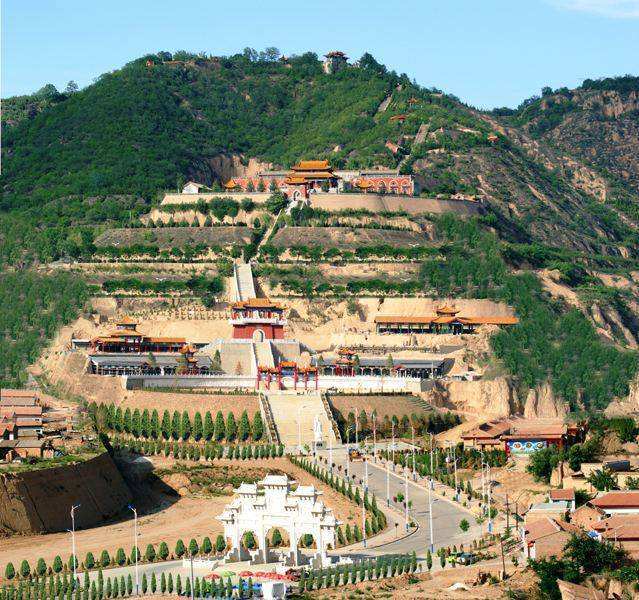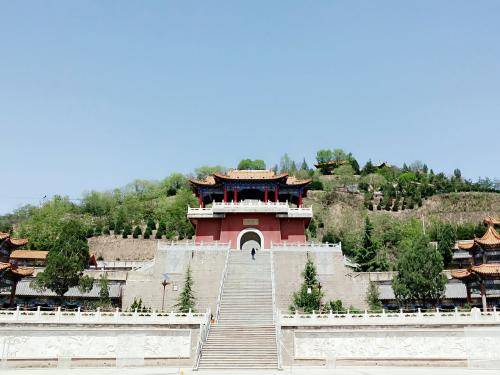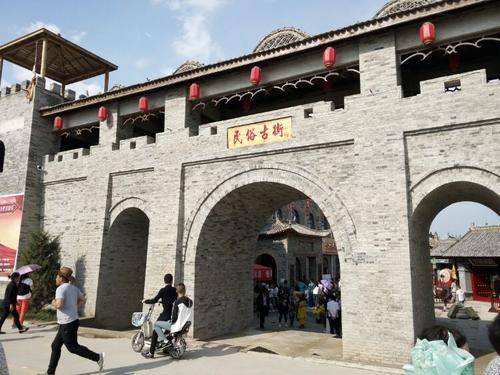Heilaoguo Ice Cave
From the winter solstice to Qingyang, you must visit the Heilaoguo Ice Cave! The natural craftsmanship is always astonishing. The Heilaoguo is composed of a stone gorge and a cave, with the stone gorge being about a kilometer long. The entrance of the cave is about 6 meters wide, with ice columns and icicles of various thicknesses hanging between the cliffs. Inside the cave, it is about 4 meters wide, with alternating ice caves and ice waterfalls. The cave ceiling is S-shaped or serpentine, with sunlight filtering through, creating varying shades of light, sometimes red, sometimes blue. The surrounding rocks are black, the gorge is long and deep, with jagged rocks and steep cliffs, shrouded in thick fog. The blackness is interspersed with red and yellow hues, resembling an iron pot used for cooking. The shape is formed by the erosion of spring water, giving it the name 'pot'.
Beishiku Temple
Beishiku Temple is located in the southwest of Xifeng District, on the red sandstone cliff of Fuzhong Mountain on the east bank of the confluence of Puhe River and Ruhe River, on the west side of Dongzhi Plateau in eastern Gansu. In the second year of Yongping during the Northern Wei Dynasty, Xikangsheng, the governor of Jingzhou, began to carve caves and statues on the cliff face under Fuzhong Mountain. Since then, it has been continuously renovated and expanded throughout various dynasties.
Nanliang Revolutionary Memorial Hall
Address: Zhaiziwan, Linzhen Township, Huachi County, Qingyang City, Gansu Province. The Shaanxi-Gansu Border Revolutionary Base is centered in Nanliang. It was a fruitful base for our party during the later period of the Agrarian Revolutionary War. It served as a foothold for the Central Committee of the Communist Party of China and various routes of the Red Army, the starting point for the Eighth Route Army's northward resistance against Japan, the foundation for the development of the Shaanxi-Gansu-Ningxia Border Region, and made outstanding contributions to the liberation of the Chinese nation. It holds significant historical importance in the history of the Chinese revolution.
Zhouzu Mausoleum
If you visit Qingyang, you can go to the Zhouzu Mausoleum Scenic Area, where agricultural culture and Qihuang health culture collide. Upon entering the Zhouzu Cultural Area, the first thing you see is the Zhaozhou Shengzu Archway, with the four large characters 'Zhaozhou Shengzu' inscribed by General Yang Chengwu on the front. Passing through the archway, you will see the Zhouzu Hall, with three statues of Zhou's ancestor, Gong Liu, in front. In the northwest corner of the Zhouzu Hall is the tomb pavilion of Zhouzu Bujue. The Bagua Pavilion is located southeast of the Zhouzu Hall, and to the south of the Bagua Pavilion is the Temple of Thirty-Eight Kings. Inside the temple, there are five intermittent mountain corridors, and inside the hall, there are thirty-eight statues and portraits from King Wen Ji Chang to King Ling Ji Yan, all with elegant designs and lifelike images. To the east of the Feiwen Pavilion is the Zanjian Stone Corridor. To the west is a pavilion for viewing the scenery, which is perfect for enjoying the landscape.
Qingyang Tianfuyi Ecological Folk Village
'Qingyang Tianfuyi Ecological Folk Village' is a demonstration project in Xifeng District aimed at transforming agricultural development methods, promoting urban-rural integrated development, increasing farmers' income, and transitioning from leisure agriculture to tourism. The village adheres to an industrialized approach to agricultural development, with agriculture as the foundation, farmers as the main body, and rural areas as the unit. It focuses on promoting industrial structure adjustment and upgrading, combining the development of modern leisure agriculture with the construction of urban green spaces, and integrating the resettlement of land-lost farmers with providing leisure sightseeing tourism for citizens.













